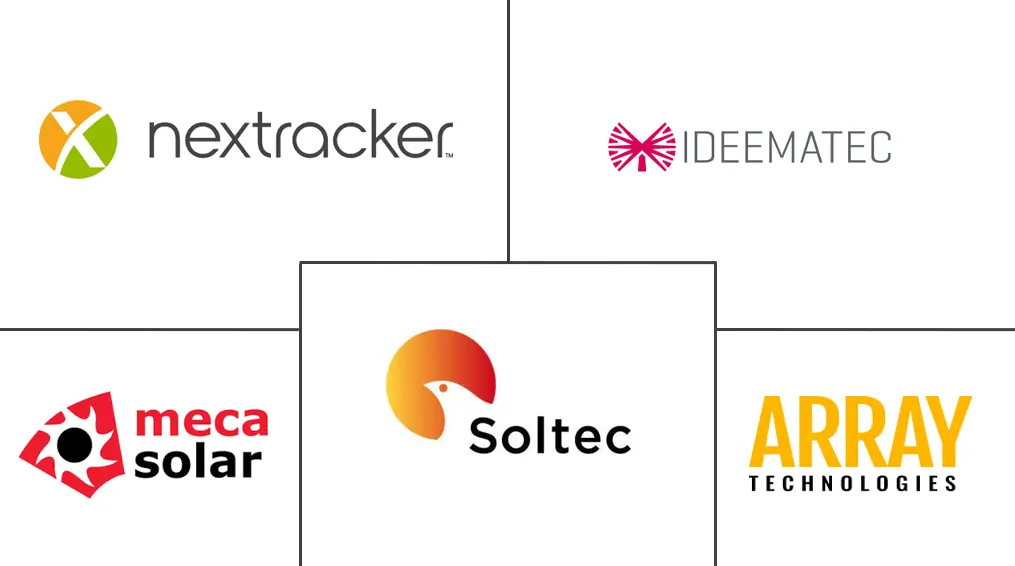Europe Single-axis Solar Tracker Market Size
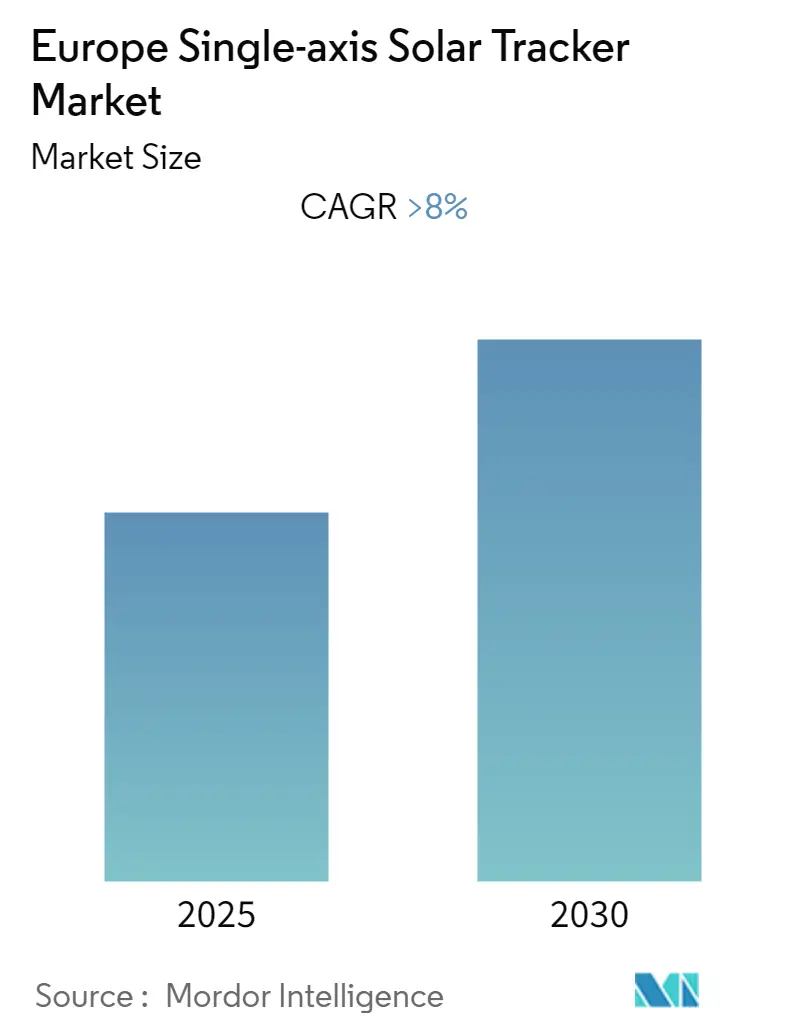
| Study Period | 2021 - 2030 |
| Base Year For Estimation | 2024 |
| Forecast Data Period | 2025 - 2030 |
| Historical Data Period | 2021 - 2023 |
| CAGR | 8.00 % |
| Market Concentration | Medium |
Major Players*Disclaimer: Major Players sorted in no particular order |
Europe Single-axis Solar Tracker Market Analysis
The Europe Single-axis Solar Tracker Market is expected to register a CAGR of greater than 8% during the forecast period.
The market was negatively impacted by the COVID-19 pandemic in 2020. Presently, the market has reached pre-pandemic levels.
- Over the medium term, the growing demand for solar power is expected to stimulate market growth. Furthermore, increasing investments and ambitious solar energy targets are expected to drive the market's growth.
- On the other hand, technical drawbacks of string inverters are expected to hamper the growth of Europe's single-axis solar tracker market during the forecast period.
- Nevertheless, product innovation and adoption of the latest technologies in single-axis solar trackers will likely create lucrative growth opportunities for the European single-axis solar tracker market during the forecast period.
- Germany dominates the market and is likely to witness the highest CAGR during the forecast period. This growth is attributed to increasing investments and supportive government policies.
Europe Single-axis Solar Tracker Market Trends
This section covers the major market trends shaping the Europe Single-axis Solar Tracker Market according to our research experts:
Increasing Investments and Ambitious Solar Energy Targets
- The European region has been witnessing significant developments in the solar industry. In 2021, nearly 25.9 GW of new solar PV capacity was connected to the European grid, an increase of 34% compared to the 19.3 GW installed in 2020. Additionally, several solar projects are either in the planning or construction phase.
- The EU had a cumulative solar photovoltaic capacity of 158.9 GW as of 2021, adding over 22.8 GW that year. Germany is the leading member of the EU-27 in terms of the highest cumulative solar PV capacity.
- For instance, in April 2021, the Germany-based Blue Elephant Energy made a development framework agreement with Umweltgerechte Kraftanlagen (UKA) to develop a 500 MW solar portfolio in Germany. It consists of 11 solar projects in an advanced development stage, with capacities ranging between 20 MW and 130 MW. Germany also aims to achieve 100 GW of solar power and a 65% share of renewables in the gross electricity consumption by 2030.
- Moreover, several other European countries have set ambitious renewable energy targets and are working toward them. In November 2021, the new European Photovoltaic Industry Association, SolarPower Europe, called on the EU to increase its renewable energy target to 45% by 2030, which is anticipated to result in an extra 210 GW of installed solar capacity.
- In February 2022, as part of a new energy strategy, France aimed to deliver more than 100 GW of installed solar PV capacity by 2050.
- Therefore, owing to these factors, solar PV is expected to grow significantly in the coming years, which is expected to create a massive demand for the single-axis solar tracker during the forecast period.
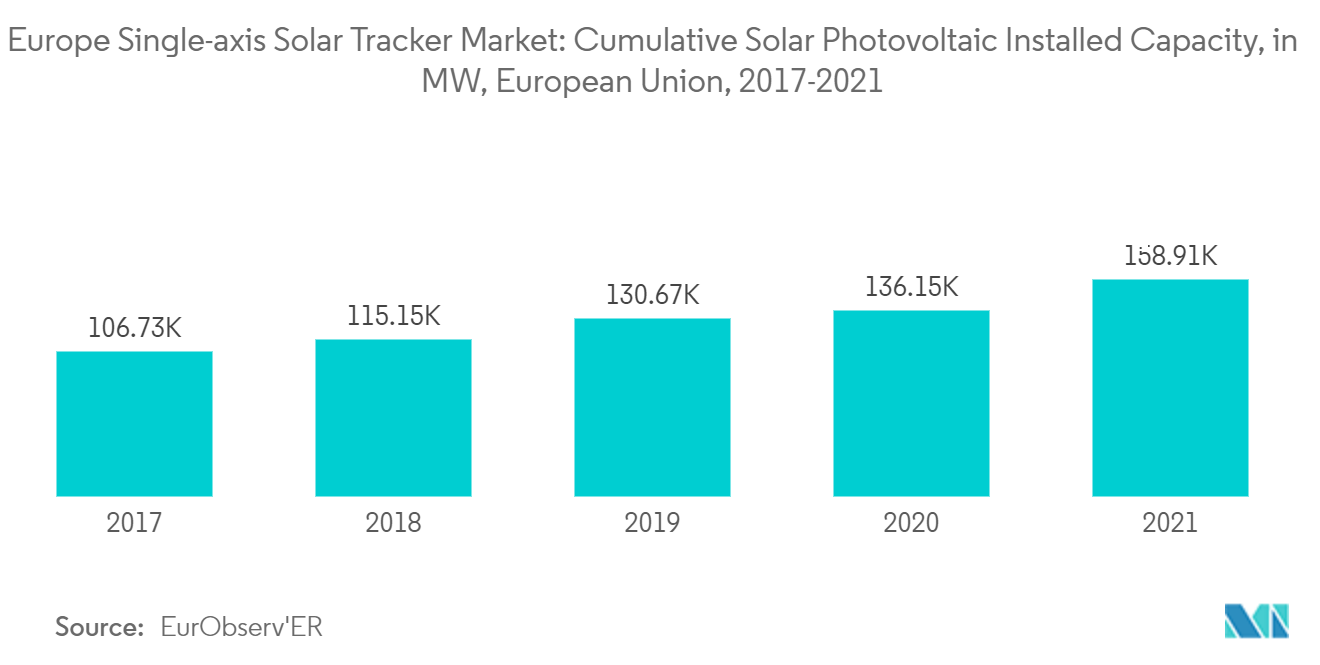
Germany to Dominate the Market
- Germany is the largest solar photovoltaic market in Europe in terms of installed capacity, which justifies it being one of the front runners in energy and climate security globally. The country has witnessed significant developments in the solar PV market and is likely to continue to do so due to a combination of self-consumption with attractive feed-in premiums, especially for medium to large-scale commercial systems ranging from 40 kW to 750 kW.
- National and regional policies have been one of the most prominent contributors to the growth of solar PV in the country. In 2020, Berlin adopted the 'Solarcity Master Plan' to expand the deployment of solar panels across the city's rooftops, with the target of supplying around 25% of the city's electricity needs with solar power by 2050. It included 27 recommendations to kickstart the solar expansion in Berlin, including incentives and education for property owners and the removal of regulatory barriers for photovoltaic systems.
- In April 2022, Germany's Economy and Climate Ministry announced the clean energy target of making up 80% of its power mix from renewables by 2030, a bump from its previous target of 65%. Currently, 40.9% of Germany's power mix consists of clean energy.
- Additionally, the country's government has also set a target of raising its solar power capacity to 200 GW by 2030, for which the country's government is planning to increase solar tenders to 20 GW.
- At the end of 2021, the country had a total cumulative photovoltaic capacity of 58.73 GW, a rise of 9.32% compared to 2020.
- In May 2022, Germany's Federal Network Agency, the Bundesnetzagentur, concluded the third rooftop PV tender with an average price of USD 0.091/kWh. The agency reviewed 171 bids with a total capacity of 212 MW and selected 163 projects totaling 204 MW. The final prices ranged between USD 0.075/kWh and USD 0.095/kWh. The second rooftop PV tender was concluded in January 2022, and the agency reviewed 209 bids with a total capacity of 233 MW, of which 136 projects were selected, totaling 154 MW. The final prices ranged between USD 0.061/kWh and USD 0.088/kWh. The final average price was USD 0.079.
- Additionally, in April 2022, Germany's Federal Network Agency announced that the agency had selected 201 proposals with a combined output of 1.084 GW under the solar auction, up from 510.34 MW in July 2021. The bids in the round ranged from USD 0.043 to USD 0.059 per kWh. The volume-weighted average price stood at USD 0.057 per kWh, up from USD 0.053 per kWh in the previous round.
- Therefore, owing to the above points, Germany is expected to dominate the European single-axis solar tracker market during the forecast period.
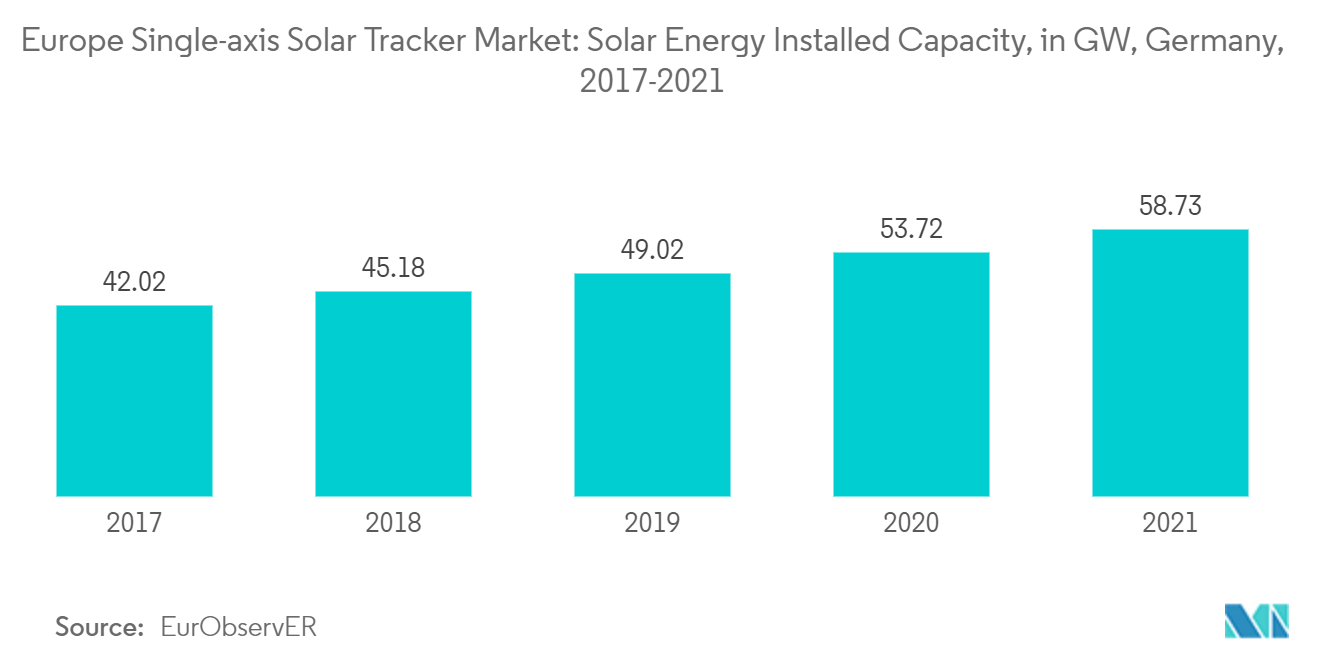
Europe Single-axis Solar Tracker Industry Overview
The European single-axis solar tracker market is moderately fragmented in nature. Some of the major players in the market (in no particular order) include Soltec Power Holdings SA, MecaSolar, Ideematec Deutschland GmbH, Nextracker Inc., and Array Technologies Inc.
Europe Single-axis Solar Tracker Market Leaders
-
Soltec Power Holdings SA
-
Ideematec Deutschland GmbH
-
Nextracker Inc.
-
MecaSolar
-
Array Technologies Inc.
*Disclaimer: Major Players sorted in no particular order
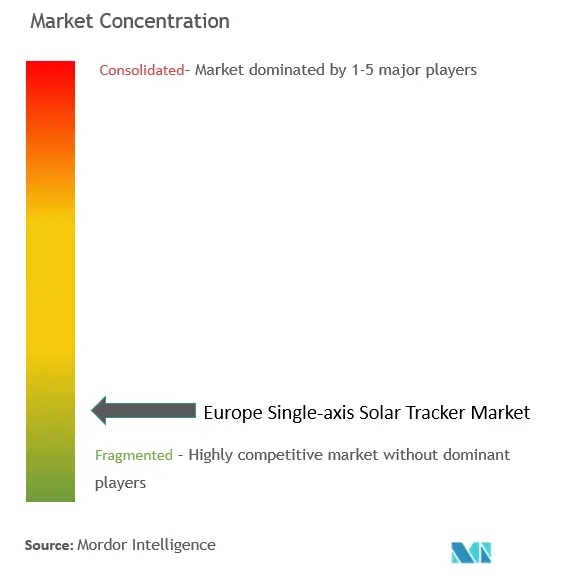
Europe Single-axis Solar Tracker Market News
- August 2022: Arctech, a global provider of tracking, racking, and buildings-integrated photovoltaics (BIPV), announced the launch of its latest solar tracking solution, SkyWings. The dual-row tracker is designed with bidirectional slew drives and a multi-point drive mechanism.
- March 2022: Nextracker launched the NX Horizon-XTR, a terrain-following, single-axis smart solar tracker that will broaden the addressable solar power market on sloped, uneven, and challenging terrain by expanding the addressable market. In the last three years, Nextracker has deployed and empirically tested the NX Horizon-XTR at a utility-scale, working closely with customers facing capital expense and construction challenges on hilly project sites. Using NX Horizon-XTR's terrain-following capabilities, grading can be reduced, steel costs can be minimized, and project risks can be decreased.
Europe Single-axis Solar Tracker Market Report - Table of Contents
1. INTRODUCTION
1.1 Scope of the Study
1.2 Market Definition
1.3 Study Assumptions
2. EXECUTIVE SUMMARY
3. RESEARCH METHODOLOGY
4. MARKET OVERVIEW
4.1 Introduction
4.2 Market Size and Demand Forecast in USD billion, till 2027
4.3 Recent Trends and Developments
4.4 Government Policies and Regulations
4.5 Market Dynamics
4.5.1 Drivers
4.5.2 Restraints
4.6 Supply Chain Analysis
4.7 Porter's Five Forces Analysis
4.7.1 Bargaining Power of Suppliers
4.7.2 Bargaining Power of Consumers
4.7.3 Threat of New Entrants
4.7.4 Threat of Substitute Products and Services
4.7.5 Intensity of Competitive Rivalry
5. MARKET SEGMENTATION - BY GEOGRAPHY
6. United Kingdom
7. Norway
8. Netherlands
9. Germany
10. Rest of Europe
11. COMPETITIVE LANDSCAPE
11.1 Mergers and Acquisitions, Joint Ventures, Collaborations, and Agreements
11.2 Strategies Adopted by Leading Players
11.3 Company Profiles
11.3.1 Soltec Power Holdings SA
11.3.2 Arctech Solar Holding Co. Ltd
11.3.3 MecaSolar
11.3.4 Ideematec Deutschland GmbH
11.3.5 Nextracker Inc.
11.3.6 DCE Solar
11.3.7 Valmont Industries Inc.
11.3.8 P V Hardware
11.3.9 Solar Flexrack
11.3.10 Array Technologies Inc.
- *List Not Exhaustive
12. MARKET OPPORTUNITIES AND FUTURE TRENDS
Europe Single-axis Solar Tracker Industry Segmentation
A single-axis solar tracker is a device that positions the panel in the direction of sunlight to draw the maximum energy possible. As the name suggests, the tracker helps the solar panels flex on the axis and change their angle with the sun's direction. The single-axis solar tracking system allows the panels to move from east to west and improve energy production. The European single-axis solar tracker market is segmented by geography into the United Kingdom, Norway, Netherlands, Germany, and the Rest of Europe. For each segment, the market sizing and forecasts have been done based on value (USD billion).
Europe Single-axis Solar Tracker Market Research FAQs
What is the current Europe Single-axis Solar Tracker Market size?
The Europe Single-axis Solar Tracker Market is projected to register a CAGR of greater than 8% during the forecast period (2025-2030)
Who are the key players in Europe Single-axis Solar Tracker Market?
Soltec Power Holdings SA, Ideematec Deutschland GmbH, Nextracker Inc., MecaSolar and Array Technologies Inc. are the major companies operating in the Europe Single-axis Solar Tracker Market.
What years does this Europe Single-axis Solar Tracker Market cover?
The report covers the Europe Single-axis Solar Tracker Market historical market size for years: 2021, 2022, 2023 and 2024. The report also forecasts the Europe Single-axis Solar Tracker Market size for years: 2025, 2026, 2027, 2028, 2029 and 2030.
Europe Single-axis Solar Tracker Industry Report
Statistics for the 2025 Europe Single-axis Solar Tracker market share, size and revenue growth rate, created by Mordor Intelligence™ Industry Reports. Europe Single-axis Solar Tracker analysis includes a market forecast outlook for 2025 to 2030 and historical overview. Get a sample of this industry analysis as a free report PDF download.

